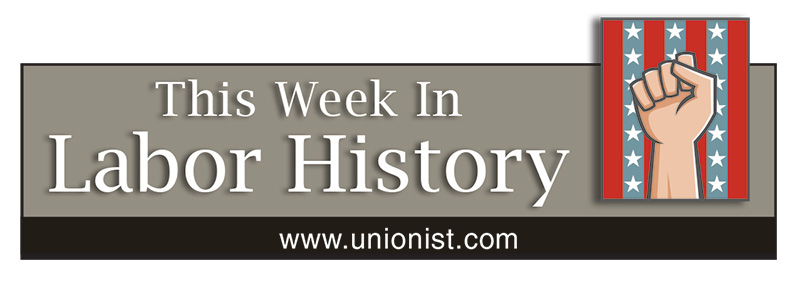
AUGUST 26
1919 – Fannie Sellins and Joseph Starzeleski are murdered by coal company guards on a picket line in Brackenridge, Pa. Sellins was a United Mine Workers of America organizer and Starzeleski was a miner.
1957 – In what some may consider one of the many management decisions that was to help cripple the American auto industry over the following decades, Ford Motor Co. produces its first Edsel. Ford dropped the project two years later after losing approximately $350 million.
1970 – The Women’s Strike for Equality is staged in cities across the U.S., marking the 50th anniversary of the passage of the 19th amendment, under which women won the right to vote. A key focus of the strike — in fact, more accurately a series of marches and demonstrations — was equality in the workplace. An estimated 20,000 women participated, some carrying signs with the iconic slogan, “Don’t Iron While the Strike is Hot.” Another sign: “Hardhats for Soft Broads”
2003 – More than 1,300 bus drivers on Oahu, Hawaii, begin what is to become a five-week strike.
AUGUST 27
1934 – Some 14,000 Chicago teachers who had gone without pay for several months finally collect about $1,400 each.
1950 – President Truman orders the U.S. Army to seize all the nation’s railroads to prevent a general strike. The railroads were not returned to their owners until two years later.
AUGUST 28
1963 – The March on Washington for Jobs and Freedom — the Martin Luther King Jr. “I Have A Dream” speech march — is held in Washington, D.C., with 250,000 participating. The AFL-CIO did not endorse the march, but several affiliated unions did.
2017 – Effective on this day, the hourly minimum wage in St. Louis, Mo., was reduced from $10 to $7.70 due to action by the Missouri Legislature prohibiting cities from setting a minimum wage rate higher than the state rate.
AUGUST 29
1889 – Sixty letter carriers from 18 states meet in a room above Schaefer’s Saloon on Plankinton Ave. in Milwaukee, where they unanimously adopt a resolution to form the National Association of Letter Carriers.
1907 – Seventy-five workers die when the lower St. Lawrence River’s Quebec Bridge collapses while under construction. A flawed design was found to be the cause. Thirteen more workers were killed nine years later when the reconstructed bridge’s central span was being raised and fell into the river because of a problem with hoisting devices.
1996 – Dancers at San Francisco’s Lusty Lady Club vote 57-15 to be represented by SEIU Local 790. Their first union contract, ratified eight months later, guaranteed work shifts, protection against arbitrary discipline and termination, automatic hourly wage increases, sick days, a grievance procedure, and removal of one-way mirrors from peep show booths.
1998 – Northwest Airlines pilots, after years of concessions to help the airline, begin what is to become a two-week strike for higher pay.
2000 – Delegates to the Minnesota AFL-CIO convention approve the launching of workdayminnesota.org, now in its fourteenth year. It was the first web-based daily labor news service by a state labor federation.
AUGUST 30
1834 – Delegates from several East Coast cities meet in convention to form the National Trades’ Union, uniting craft unions to oppose “the most unequal and unjustifiable distribution of the wealth of society in the hands of a few individuals.” The union faded after a few years.
1996 – OSHA publishes scaffold safety standard, designed to protect 2.3 million construction workers and prevent 50 deaths and 4,500 injuries annually.
AUGUST 31
1921 – Some 10,000 striking miners begin a fight at Blair Mountain, W.Va., for recognition of their union, the United Mine Workers of America. Federal troops were sent in and miners were forced to withdraw five days later, after 16 deaths.
1980 – “Solidarity” workers movement founded as a strike coordination committee at Lenin Shipyards, Gdansk, Poland. The strike launched a wave of unrest in the Soviet Union that ultimately led to its dissolution in 1991.
1991 – An estimated 325,000 unionists gathered in Washington, D.C., for a Solidarity Day march and rally for workplace fairness and healthcare reform.
1999 – Detroit teachers begin what is to become a nine-day strike, winning smaller class sizes and raises of up to four percent.
SEPTEMBER 1
1894 – Congress declares Labor Day a national holiday.
1903 – Some 30,000 women from 26 trades march in Chicago’s Labor Day parade.
1934 – A three-week strike in Woonsocket, R.I., part of a national movement to obtain a minimum wage for textile workers, resulted in the deaths of three workers. Ultimately more than 420,000 workers struck nationally.
1946 – In Hawaii, some 26,000 sugar workers represented by the Longshoremen’s union begin what is to become a successful 79-day strike that shuts down 33 of the 34 sugar plantations on the islands. The strike brought an end to Hawaii’s paternalistic labor relations and impacted political and social institutions throughout the then-territory.
2013 – Margaret Mary Vojtko dies at age 83 in Homestead, Pennsylvania. She was an adjunct professor of French and medieval literature at Duquensne University for 25 years — a pay-by-the-courses-taught part-time with no benefits — before being told her contract wouldn’t be renewed, but was offered a tutoring job at two-thirds her old salary. She was making so little that she slept in her office, being unable to afford to heat her home because of medical bills. She had been active in trying to form an adjunct’s union. She died five months after being fired.
(Labor History is provided by Union Communications Services, since 1981 North America’s premier publisher and distributor of newsletters, leadership training programs for shop stewards and officers, website materials and other powerful use-it-today strategies and tools to help leaders and activists build union power. Reach them at unionist.com.)

